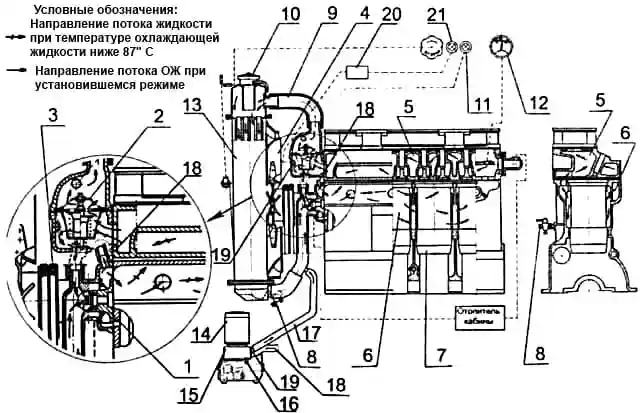Closed type engine cooling system, with forced circulation of coolant from a centrifugal pump
The temperature of the coolant in the system is controlled by a remote thermometer, the sensor of which is installed in the cylinder head.
In addition, a coolant temperature warning light sensor is installed in the thermostat housing cover.

Attention! It is forbidden to operate a diesel engine when the warning light for the emergency temperature of the coolant in the cooling system lights up.
The temperature of the coolant in the cooling system must be maintained between 85 and 95 ° C.
To accelerate the warm-up of the diesel engine after start-up and automatically control the temperature regime at various loads and ambient temperatures, a thermostat with a main valve opening temperature of 87±2 °C is used.

The thermostat with a solid filler is designed to accelerate the warm-up of the engine after the start of automatic temperature control at various loads and ambient temperatures.
The expansion tank is designed to compensate for changes in the volume of coolant when heated and to remove air.
The fluid pump and generator are driven by the engine crankshaft pulley using two belts.
The engine cooling fan is driven from the crankshaft pulley through the intermediate support pulley.
Attention! To avoid scale formation and damage to the engine, do not use water in the cooling system.
In the event of malfunctions associated with a coolant leak, short-term use of water is allowed until the malfunction is corrected.
Cooling system maintenance
When servicing the cooling system, the liquid level in the expansion tank is checked daily and the tightness of the connections is monitored.
It is not allowed to operate the bus with an empty expansion tank. The liquid level must be above the "MIN" mark on the tank body.
An anti-freezing liquid should be used as a coolant in the system.
To avoid scale formation, do not use water in the cooling system.
If a coolant leak occurs, short-term use of water is allowed until the malfunction is eliminated.
The density of the low-freezing liquid should be checked before the beginning of the cold season, and after each repair of the cooling system associated with a coolant leak.
External signs (color, smell, etc.) do not allow you to correctly determine the quality of the coolant.
Once a year in autumn, the coolant should be changed when performing maintenance.
Before changing the fluid, you need to make sure that the system is tight.
Attention! The use of a coolant of insufficient density can cause engine destruction.
Watch the coolant temperature. Normal operating temperature should be 85-95°C
When the temperature rises above the operating temperature, check the coolant level in the expansion tank, if necessary, in the radiator, check the tightness of the radiator and piping, check the tension of the fan belts and their condition.
If necessary, but at least every 120 thousand km of the bus run, flush the cooling system from contamination.
For washing, use a solution of 50-60 g of soda ash per 1 liter of water.
Flush the system in the following order:
- - pour 2 liters of kerosene into the radiator and fill the system with the prepared solution;
- - start the diesel engine and run for 8-10 hours or 350-400 km, then drain the solution and flush the cooling system with clean water.
The tension of the fan belt between the crankshaft pulley and the intermediate support is performed by turning the eccentric axis of the intermediate support after loosening the nuts of its fastening.
The tension of the belt between the fan pulleys and the intermediate support is performed by a tension roller.
The alternator and water pump drive belts are tensioned by turning the alternator housing.
The tension of the compressor drive belt on the D-245.9EZ diesel engine is carried out by a roller through the tension mechanism.
Before tightening, loosen the idler axle lock bolt and adjusting screw lock nut.
Then, by turning the nut on the adjusting screw, move the screw together with the tension roller.
Tension control is carried out with a spring dynamometer according to the belt deflection or using the KI-8920 device.
Belt deflection under a load of 4 ± 0.2 kgf should be:
- - in the area between the pulleys of the crankshaft and the intermediate support - 14-20 mm;
- - in the area between the pulleys of the intermediate support and the fan shaft - 13-18 mm.
- - in the area between the pulleys of the crankshaft and the generator - 15-22 mm;
- - in the area between the pulleys of the generator and the water pump - 7-12 mm.
- - in the area between the pulleys of the crankshaft and the compressor - 15-22 mm;
If one of the belts is worn or damaged, replace as a set (both belts).
Litol-24 grease is put into the bearing cavity of the water pump during assembly and is replaced only after repair (disassembly) of the assembly.
Water pump bearings, fan shaft and intermediate fan support do not require lubrication during the entire period of operation.





